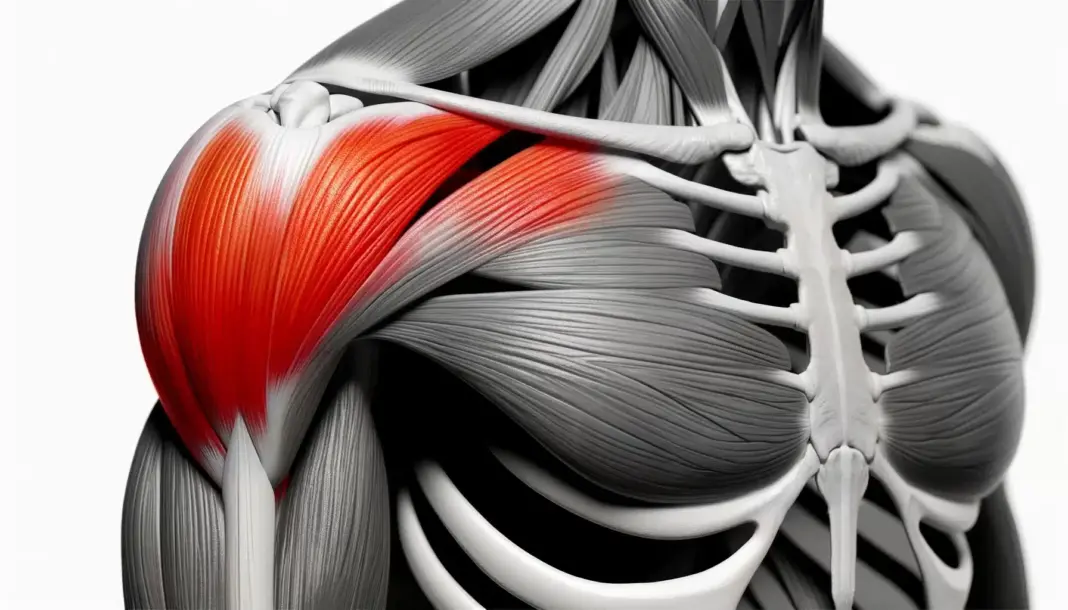Best Front Deltoid Exercises for Size and Pressing Strength
The front deltoids (anterior delts) are the driving force behind pressing strength and upper-body thickness. Every bench press, military press, and dip you perform involves the front delts to some degree.
Yet, most lifters either overtrain them accidentally (too much pressing) or undertrain them directly (ignoring isolation work).
If you want bigger shoulders, a stronger press, and a balanced physique, you need a deliberate front delt strategy.
This guide breaks down the best front deltoid exercises, training strategies, and practical programming advice for lifters of all levels.
Anatomy of the Front Deltoid
The anterior deltoid originates from the clavicle and inserts on the humerus. Its primary functions include:
- Shoulder flexion – raising your arm in front of your body.
- Horizontal adduction – bringing your arm across your chest.
- Internal rotation – turning the arm inward.
In bodybuilding terms:
- A thick, round front delt makes your chest and shoulders look fuller from the front.
- Stronger front delts boost overhead and bench pressing numbers.
- Balanced anterior delt development prevents shoulder injuries from muscle imbalances.
Best Front Deltoid Exercises
Overhead Barbell Press (Military Press)
The gold standard for front delt strength.
- Why it works: Heavy barbell loading builds pressing power and delt mass.
- Tips: Keep your core braced and avoid excessive lower back arch. Lower the bar to just below chin height for optimal shoulder stress.
Dumbbell Shoulder Press
More freedom of movement than the barbell, less stress on the joints.
- Why it works: Dumbbells force both sides to work equally, reducing imbalances.
- Tips: Use a neutral grip if you have shoulder discomfort.
Arnold Press
Named after Schwarzenegger for a reason.
- Why it works: The twist at the bottom increases delt range of motion, engaging the front delts more fully.
- Tips: Don’t go too heavy — control the rotation to avoid shoulder strain.
Incline Dumbbell Press
Chest + shoulders in one move.
- Why it works: A 30–45° incline shifts more emphasis to the front delts compared to flat pressing.
- Tips: Keep shoulders retracted to avoid turning it into a chest-dominant movement.
Front Raises (Dumbbell or Plate)
Classic isolation exercise for the anterior delts.
- Why it works: Directly targets shoulder flexion, which is the primary function of the front delts.
- Tips: Perform slow and controlled — don’t swing the weight. Stop at shoulder level.
Landmine Press
Perfect for lifters with cranky shoulders.
- Why it works: The angled pressing path reduces stress on the shoulder joint.
- Tips: Great as a secondary pressing movement or for high-rep pump work.
Handstand Push-Ups (Advanced)
A bodyweight powerhouse move.
- Why it works: Overhead pressing without weights, requiring balance, stability, and serious front delt activation.
- Tips: Start with pike push-ups if full handstands are too advanced.
Front Delt Training Strategies
Frequency and Volume
- Beginners: 8–10 sets per week (via compound pressing).
- Intermediates: 10–15 sets per week (add direct isolation).
- Advanced: 15–20 sets per week (front raises, landmine presses, higher frequency).
Exercise Selection
- Prioritize one heavy press (barbell/dumbbell) + one isolation movement (front raises, Arnold press).
- Rotate incline pressing to hit both chest and delts without overlap.
Progression
- Add reps before weight on isolation work.
- Use double progression (reps + weight) for compound presses.
Avoid Overtraining
Too much pressing = overdeveloped front delts + underdeveloped side/rear delts.
- Balance with side lateral raises and rear delt work every week.
Sample Front Delt Workouts
Beginner (2x per week)
- Overhead Press – 3×8–10
- Incline Dumbbell Press – 3×10–12
- Dumbbell Front Raise – 3×12–15
Intermediate (2–3x per week)
- Barbell Military Press – 4×6–8
- Arnold Press – 3×10–12
- Landmine Press – 3×12–15
- Dumbbell Front Raise (drop set) – 2×15–20
Advanced (3x per week, high volume)
- Overhead Press – 5×5
- Incline Barbell Press – 4×8–10
- Arnold Press – 4×12
- Front Raise (plate or dumbbell) – 3×15–20
- Handstand Push-Ups – 3 sets to failure
Common Front Delt Training Mistakes
- Overlapping volume (too much pressing across chest + shoulders).
- Neglecting side and rear delts (leads to imbalances).
- Using momentum on front raises (defeats the purpose).
- Not adjusting grip or angle when shoulder discomfort sets in.
Practical Takeaways
- The overhead press is king for front delt mass and strength.
- Balance your training: strong front delts are useless without side and rear delt support.
- Use a mix of compounds for strength and isolations for shape and detail.
- Train front delts directly 1–2 times per week, but don’t neglect the rest of your shoulders.
Conclusion
The front deltoids are already heavily involved in most pressing movements, but if you want truly dominant shoulders, you need targeted work.
Combine heavy overhead presses with controlled isolation exercises, and your front delts will not only grow — they’ll unlock pressing strength across your entire upper body.





